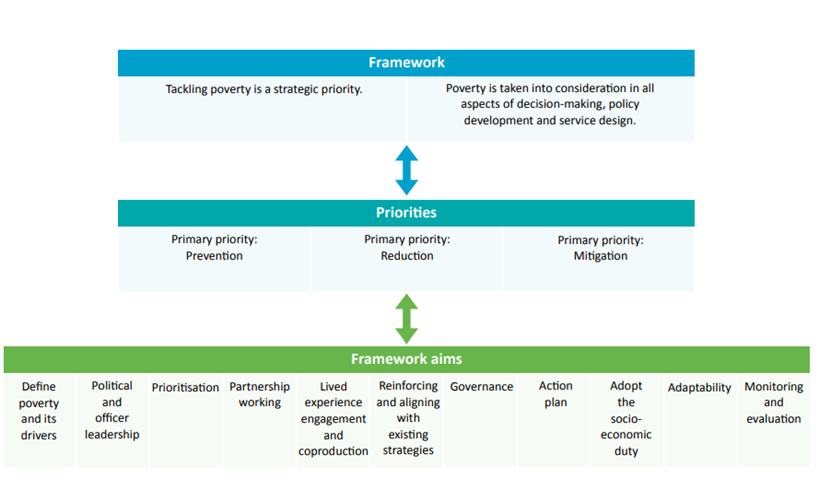In light of the UK government’s failure to take decisive action in the face of rising poverty levels across the country, local authorities are stepping up with their own plans. Penny Rimmer explains how these responses can be made most effective.
The UK is facing an unprecedented poverty crisis. The consequences of poverty are significant and far-reaching, yet poverty is preventable and can be reduced with the right political will. The government has the power to tackle poverty, but there is no coherent plan or strategy for tackling poverty at a national level. This has left local authorities and their public, voluntary, community social enterprise (VCSE), and private sector partners without any clear direction or leadership from central government as to their role in addressing poverty locally.
Lacking statutory guidance, limited and declining powers and insufficient funding from the government increases the challenges facing local authorities and their partners in fighting poverty. Nonetheless, a number of local authorities in England have taken proactive anti-poverty measures by adopting a strategic approach, developing and implementing local anti-poverty strategies, and committing to taking a local leadership role in response to escalating poverty levels.
With more and more localities in Greater Manchester, supported by GMPA, and across the country interested in understanding how they can tackle poverty locally, our recent report, Local anti-poverty strategies – good practice and effective approaches, delves into the strategic approach local authorities and their partners can take to address poverty and identifies the key elements of a local anti-poverty strategy that will maximise its effectiveness.
What do we mean by a local anti-poverty strategy?
In our report, we emphasise the importance of understanding what local anti-poverty strategies are and what they are not. Recognising the essential elements that distinguish an effective strategy from a collection of initiatives is crucial. A robust, local anti-poverty strategy involves:
- identifying the key issues contributing to poverty;
- establishing clear priorities for action;
- embracing a commitment to cultural change;
- fostering collaborative partnerships across multiple stakeholders and aligning with and complementing existing strategies.
Ultimately, a local anti-poverty strategy must strive to make a lasting positive impact on the lives of those facing the greatest financial hardships.
However, a local anti-poverty strategy cannot be considered genuine if it is merely shelved away, collecting dust as an internal document. Similarly, presenting a list of existing initiatives undertaken by a local authority to address poverty falls short of meeting the criteria of a comprehensive anti-poverty strategy. A genuine strategy demands a proactive and dynamic approach beyond a passive compilation of efforts, offering a framework for coordinated and sustainable action that is open to scrutiny from external and internal stakeholders.
The value of a strategic approach
Understandably, there will be apprehension about what value an anti-poverty strategy adds. Translating what local authorities and partners would ideally like to do into the reality of practical change is complex and challenging given the current context. There may also be questions about local authorities already doing this work, so what does a local anti-poverty strategy add?
The report analyses six local anti-poverty strategies implemented across the country: Salford City, Rother District, East Devon District, Cambridge City, Leicester City, and Scottish Borders. From scope and design to aims and measures of success. Our findings have shown that local anti-poverty strategies add value in three distinct ways.
Our findings have shown that local anti-poverty strategies add value in three distinct ways.
Firstly, they set clear objectives and set out how they will be achieved, underpinned by a shared understanding of poverty and its causes. Secondly, they improve coordination and empower key local stakeholders to do more to address poverty as there is a coherent framework helping to marshal limited resources and capacity and fostering a collective determination to address the issue across partners. Thirdly, they increase accountability for action as they provide measurable targets to determine whether the actions set out are making a difference, but there is an emphasis on longevity and the ability to learn as the strategy progresses.
Key elements of a local anti-poverty strategy
Based on the findings, we have developed a framework identifying the elements a local anti-poverty strategy needs to maximise its effectiveness.

The key elements identified above are to be used as the basis for developing or enhancing local anti-poverty strategies. This recognises that a local place-based approach is needed and that existing content, such as levels of poverty and deprivation, local demographics, and the nature of existing partnership working across agencies, are among a range of factors that will shape how an anti-poverty is formulated and how it will operate in practice. Good practice is not static; strategies must be sustainable in completing current actions and adapting to future needs and changes.
There is no “silver bullet” to address poverty. While the main drivers for change lie with national government, local authorities and their partners have a significant role to play based on their remit and expertise. Our findings have demonstrated that local anti-poverty strategies can serve as a vehicle for progress. However, for these strategies to be effective, they must be grounded in realism, feasibility and active collaboration with key local stakeholders. A good understanding of poverty, coordinated efforts and the availability of resources are crucial components to addressing the specific needs within communities.
Despite the existing determination to do better, the potential of local anti-poverty strategies in building resilient communities remains largely untapped. Anti-poverty organisations such as GMPA continue to build on this work, working closely with local authorities in Greater Manchester and beyond to implement and strengthen local responses to poverty. With the right advice and guidance, local authorities can be at the forefront of working towards a more equitable society where poverty is reduced and individuals have equal opportunities to thrive.
This post draws on the report “Local anti-poverty strategies: Good practice and effective approaches”. You can read the report in full on the GMPA website.
All articles posted on this blog give the views of the author(s), and not the position of LSE British Politics and Policy, nor of the London School of Economics and Political Science.
Image credit: Photo by Nico Smit via Unsplash





